Cash retention under construction contracts: consultation analysis
Findings of a public consultation on the practice of cash retention in public and private sector construction contracts in Scotland and to gather views on the findings of the supporting documentation.
4. Summary of responses
Section A: Supporting Documentation and the Pye Tait Report - Retentions in the Scottish Construction Industry
In line with the Pye Tait conclusion (hereby referred to as 'the report'), respondents were almost in unanimous agreement (85% 'fully agreeing', 9% 'partially agreeing') that the "financial consequences for contractors and subcontractors in the event of a large organisation going into liquidation can be significant". Only 6% of respondents 'partially disagreed'.[12]
Respondents were also largely in agreement (67% 'fully agreeing' and 3% 'partially agreeing') with the report's conclusion that "retention money held in a main bank account can be used by the holder to fund expenditure on labour, plant and materials on other projects and/or as part of working capital'[13]. However, 15% 'disagreed' and 9% 'partially disagreed' with this conclusion.
Figure 3 shows that while there were more respondents who agreed than disagreed, there was more of a spread of answers from respondents regarding the conclusion that "some companies deliberately avoid business in which retentions are involved"[14].
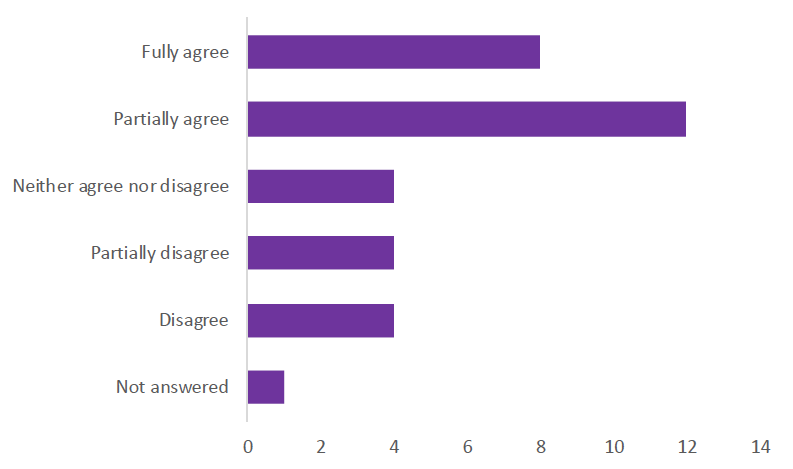
Most respondents agreed with the report's finding that an area for potential further investigation was that 'alternatives to common retention practices are available but used infrequently':[15] 67% 'fully agreed' and 21% 'partially agreed' (3% 'disagreed' and 6% partially disagreed')
As Figure 4 shows, respondents were split on the report's conclusion that "the retention system in Scotland works reasonably well when all parties adhere to the letter and spirit of the agreement',[16] with 30% 'fully agreeing' and 'disagreeing':
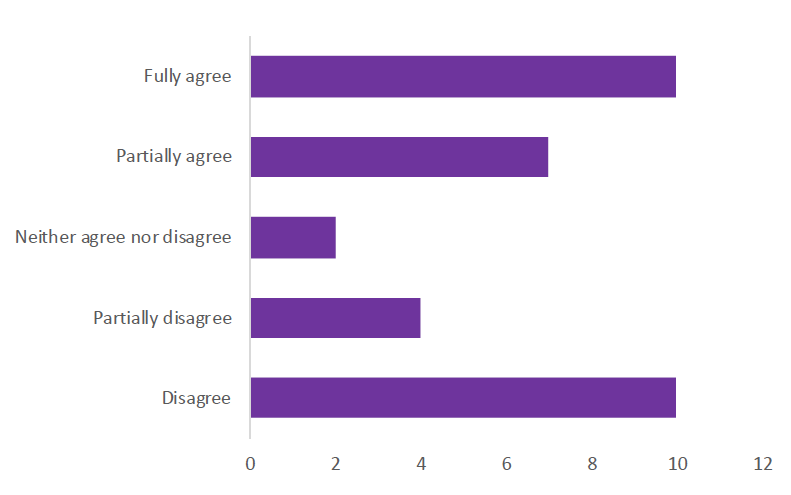
Respondents selected what they believed to be the main intended purpose of the retentions scheme. Most thought that the scheme was a way to 'encourage sub-contractors to return to fix any defects' and as a means of funding 'works required to fix defects in the event that the sub-contractor did not return' (table 1 overleaf). (Ten respondents also thought that retentions worked as a 'warranty against poor quality work'.)[17]
| Total | % | |
|---|---|---|
| To encourage sub-contractors to return to fix any defects |
23 |
70% |
| To fund works required to fix defects in the event that the sub-contractor did not return |
23 |
70% |
| To act as a warranty against poor quality work |
10 |
30% |
| Other* |
5 |
15% |
* Reputable firms will always return to fix defects and do not require retentions as an "incentive" (1); To protect against sub-contractor insolvency (1); To protect main contractor against insolvency (1); It is a pot of money that main contractors see as their potential margin (1); A way for major contractors to keep capital as long as possible. Unless a sub-contractor really pushes for it to be paid it is never paid or paid in full (1).
When asked whether they thought 'some form of assurance is needed in construction contracts[18]', the response was almost unanimous: 94% agreed with this and only 6% disagreed.
However, when asked how 'effective do you feel the current system of retention is'[19] there was a mixed response by respondents: 36% thought it was 'not effective at all' and only 9% thought it was 'very effective' (39% thought it was 'partially effective' and 15% thought it was 'slightly ineffective; 9% thought it was 'neither effective nor ineffective').
A majority of respondents thought that retentions were not 'the best form of assurance within construction contracts'[20] (figure 5) (twenty-two respondents said 'no', eleven said 'yes'):

For the respondents that answered 'No' (n22) to the above question, these respondents gave the following answers when asked 'what other form of assurance they would prefer'[21] (table 2) (it should be note that there was far from a consensus and nine of the possible twenty-two did not provide an answer):
| Retentions bonds | 5 | 15% |
|---|---|---|
| Performance bonds | 1 | 3% |
| Escrow stakeholder accounts | 4 | 12% |
| Parent Company guarantees | 4 | 12% |
| Other* | 10 | 30% |
| Not answered | 9 | 27% |
* Please see Annex C for full list of written responses
When asked whether they agreed or not with the recommendation made within the report 'That action should be taken to create a fairer, more neutral and more protected approach to the practice of retentions[22]' the majority were in agreement: 76% said 'yes' (n25), with 24% saying 'no' (n8) (see Annex D for additional supporting reasons given in explaining these selections).
Of those that answered 'yes' (n25) to the above question, when asked 'what would you suggest for the practice of retentions'[23], nine suggested "ban the practice of retentions" and five respondents said "no action – I'm happy with current system of retention" (it should be noted that the majority (n19) did not answer).
For the question of whether respondents 'actively avoid bidding for contracts subject to retention'[24], only a minority of 9% outright reject this statement (table 3 overleaf):
| Yes | 3 | 9% |
|---|---|---|
| No | 9 | 27% |
| It depends on the value / type of contract | 10 | 30% |
| Not applicable | 7 | 21% |
| Not answered | 4 | 12% |
Related to the above question, respondents were also asked if they would 'bid for contracts if an alternative to the current practice of retention was established or as Pye Tait recommend a "fairer, more neutral and protected approach to the practice of retentions''[25]. Most respondents said 'yes' to this (n13), and only four saying it 'would depend on the type of contract' and only two saying 'no' (eight were clients and not applicable, six did not answer).
Respondents were asked 'If you were unable to use retentions what method of assurance would you use'/.[26] As figure 6 highlights, no one option was significantly preferred:

For the last question in this section respondents were asked if their cashflow would be affected if they 'were unable to use retentions'[27]. Of those respondents who answered, five said 'Yes, I hold retentions in a main bank account', four said 'No, I hold retentions in a separate account, and eleven 'did not hold retentions from others'.
When asked the follow up question of what 'impact would not being able to use retentions for cashflow have on your business'[28], most did not believe there would be much impact: five said it would be 'neither significant nor insignificant' and one said it would be 'fairly insignificant' and one said 'none', whereas only two said it would be 'very significant' and three said it would be 'slightly significant'.
Section B: Non-Payment of the Retention
When asked how significant an issue 'non-payment of retentions is in the construction sector'[29], the clear majority thought it was 'very significant' or 'fairly significant', 58% and 24% respectively.
When asked what the 'main reasons for non-payment of retentions'[30] were, a wide range of answers were provided. Of the options given, seventeen said 'insolvency', fourteen 'contractors not returning to finish work', and only four said 'poor quality of work'.

Several others referenced the behaviours of the main contractor, including refusing to pay or avoiding paying because:
- know that legal action would be relatively too costly to pursue.
- use sub-contractors money as free banking.
- are unable to resolve defects satisfactorily.
- use release of retention as leverage to diminish a Final Account Value or to simply negotiate a further discount and
- hope that sub-contractor will just forget about it.
For those holding retentions in the past 12 months[31] there was a mixture of answers to the question of what the reasons for withhold payment of retentions:
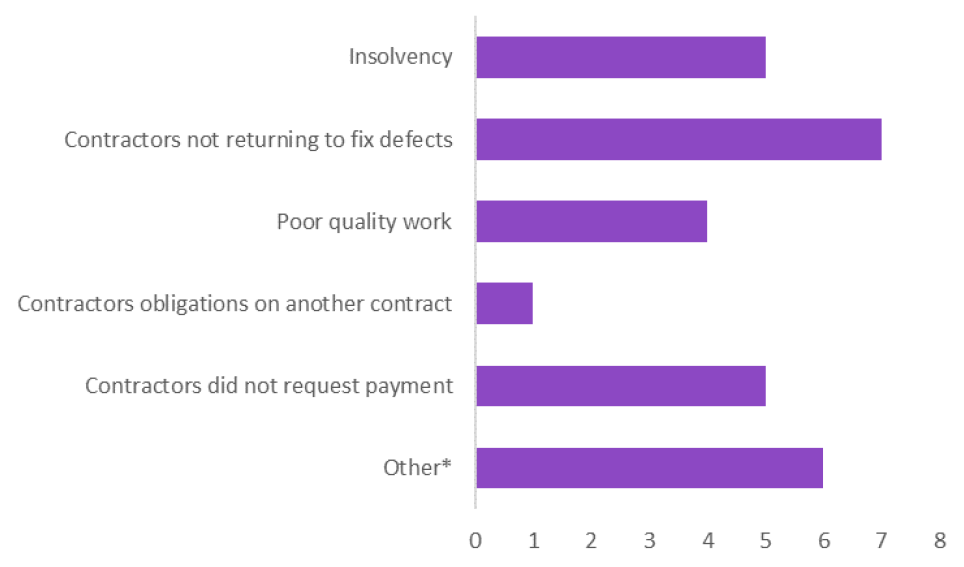
Similarly, a mixture of answers were also given when respondents were asked what the reasons were for non-payment if they have been subject to a retention within the last twelve months and this was not repaid[32] (Figure 9):
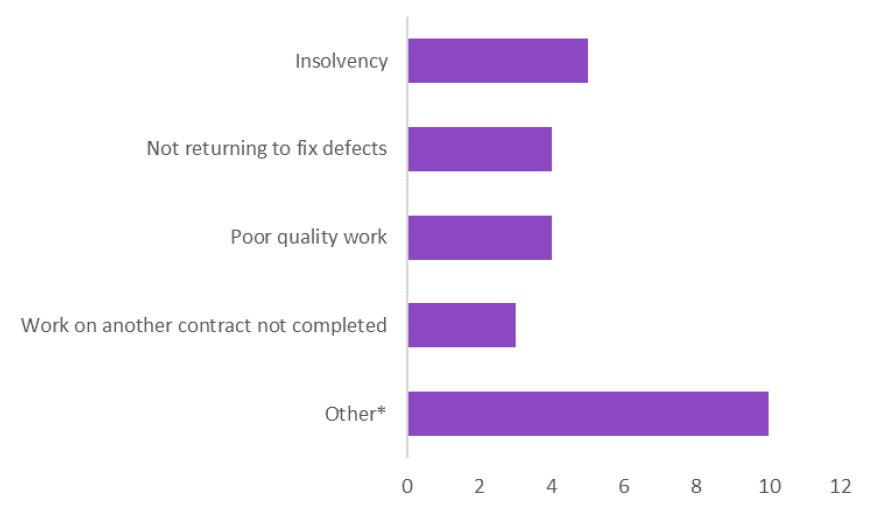
Of 'the total value of retentions due to be released'[33] to and by respondents in the past 12 months, most were under £200k with a small number above this figure. Similarly, where 'retention money was due'[34] to respondents, most were under £100k with a lower amount at the higher end of above £200 (Table 4, overleaf).
| £ released | £ due | |
|---|---|---|
| < £10k | 5 | 5 |
| £10k - £50k | 6 | 5 |
| £50k - £100k | 3 | 0 |
| £100k - £200k | 2 | 1 |
| £200k - £500k | 1 | 3 |
| > £500k | 5 | 0 |
| Total | 22 | 14 |
A small number of respondents also provided further information on the amount of retention not released[35] by certain categories:
| No. of respondents | Total | Median £ | |
|---|---|---|---|
| Insolvency | 3 | £32,200 | £6,500 |
| Payer cited that obligations under another construction contract had not been met | 2 | £20,000 | £10,000 |
| I did/contractor did not return to fix defects | 4 | £113,500 | £15,000 |
| Poor quality work | 2 | £15,000 | £7,500 |
| I did/contractor did not claim payment of the retention | 4 | £103,400 | £20,000 |
| Other reasons | 3 | £25,100 | £3,250 |
Of the unpaid retentions, on average respondents (n10) believe that approximately 60% were unjustified[36]. Some of the reasons for this are included below[37]:
- If main contractor does not complete their own defects the client does not pay them and in turn they do not pay the sub-contractor. This is even when sub-contractor has carried out any notified defects.
- There is no protection of money retained if the Main Contractor or Client becomes insolvent.
- Pay when Paid most common retort. "We still do not have the Making Good Defects Certificate under the Main Contract....."
- No demonstration of liability was made for the claimed defects.
- Works completed including all defects but due to the Main Contractor not obtaining their Making Good Defects Certificate releasing their retentions then they held onto monies due attempting to go back to back with releases relative to their contract.
When asked whether they challenged the non-payment of retention 'that occurred due to the payer citing obligations under another construction contract not being met' there was fairly even split with ten saying they did and eight did not.[38]
Of those that challenged, two said payment was then made, one said partial payment was made, two said payment was disputed, and two said nothing happened.[39]
Section C: Late Payment of the Retention
Similar to the majority of responses that non-payment was an issue, likewise the majority of respondents also thought 'late payment'[40] was an issue for the construction sector (Figure 10 overleaf):

Respondents were asked to supply the total value of retentions due to be released by them that was paid late.[41] Of those that did make late payments, most were under £100k, with a small number £200k and above (table 6):
| £ | % | |
|---|---|---|
| < £10k | 3 | 9% |
| £10k - £50k | 6 | 18% |
| £50k - £100k | 2 | 6% |
| £100k - £200k | 0 | 0% |
| £200k - £500k | 3 | 9% |
| > £500k | 1 | 3% |
| Not applicable | 13 | 39% |
| Not answered | 5 | 15% |
A small number of respondents also provided further information on the amount of retention released[42] late by certain categories (Table 7 overleaf):
| No. of respondents |
Total |
Median £ |
|
|---|---|---|---|
| I did not meet the provisions of my contract |
3 |
£175,000 |
£75,000 |
| Payer cited that obligations under another construction had not been met |
2 |
£150 |
£75 |
| The company holding the retention cited cash flow problems |
3 |
£82 |
£27 |
| Poor quality work |
3 |
£160,000 |
£5,000 |
Of the retentions paid late, the majority (n8) estimated that between 75 – 100% of these had been unjustified, with only two believing this to be 51 – 75% and three believing it between 26 – 50%.[43]
For the amount of time they believed to have been unjustified, three waited between 1 – 3 months, six waited 3 – 6 months, three waited 6 – 12 months and two waited over a year.[44]
Seventeen respondents provided an estimate of the cost to their business in 'pursuing late (including those that were ultimately unpaid) retention payments over the last twelve months'[45] with the total cost being £181,880 and the median cost of £2,500 (note that five respondents claimed that this process cost nothing, thus lowering the median – when removing these five the median rises to £6,500).[46]
When asked whether they challenged the late payment that occurred due to the payer citing that obligations under another construction contract had not been met'[47] seven saying they did and none did not (sixteen said it was not applicable to them and ten did not answer).
Of those that did challenge,[48] three reported payment being made. One said 'partial payment' was made, two said 'nothing happened', one has 'resorted to legal action', and one said they had 'decided not to continue pursuing due to cost' (twelve said it was not applicable and thirteen did not answer).
Respondents were also asked if they had been previously been aware that 'the 2011 amendments to the "Housing Grants, Construction and Regeneration Act 1996" mean it is no longer possible to make payment, including retention payments, conditional on the performance of obligations under another contract'[49], to which the majority of 58% said they had, with 27% said they had not (15% did not provide an answer).
When asked if they would have 'challenged the late-payment (due to performance of obligations under another contract), if you had known that this is what the "Housing Grants, Construction and Regeneration Act 1996" means for retention payments'[50], five said yes, one saying no, and four saying that it depended on the value of the contract (fourteen were not applicable and nine did not answer)
Respondents were asked for their thoughts on how future amendments to the "Housing Grants, Construction and Regeneration Act 1996" be better promoted to raise awareness.[51]
- Publicised through industry bodies
- Webinar and online training sessions
- Target learning to small and medium sized contractors
- Scottish Government should publish advice clearly stating legal responsibilities
Respondents were split when asked whether they had encountered 'companies which artificially inflate their tender price where a retention is being applied',[52] with ten saying they had and twelve saying they had not, with six being unsure.
Section D: Existing Alternative Mechanisms to Retentions
Over the last twelve months, a small number of respondents said they had either alternative mechanisms to retentions in place or alternative mechanisms for implementing retentions.[53] Three used 'retention bonds', two used 'performance bonds', and one used 'parent company guarantees (PCGs). None had used 'escrow stakeholder accounts' or 'retentions held in a trust'[54] (twenty-five did not answer).
An equal number of respondents (n5) used these mechanisms in addition to or as an alternative to retentions [55] (twenty-three did not answer).
When asked what options they thought should be 'applicable for wider use across the whole sector',[56] most respondents (42%) agreed that retentions should be held in trust, with 27% agreeing with retention bonds and 24% saying escrow stakeholder accounts (figure 11).

Respondents were almost split when asked whether they thought it was 'important for Scotland to use the same mechanism of assurance in constructions contracts as the rest of the UK' with eleven disagreeing or partially disagreeing and twelve fully agreeing or partially agreeing (figure 12). This split in support was the case regardless of whether respondents were from organisations that worked exclusively in Scotland or those that worked across the UK.

The majority of respondents fully agreed and partially agreed (42% and 24% respectively) that 'retention deposit scheme and/or holding retentions in trust could eliminate some of the critical issues associated with retentions (notably the risk of delayed or non-payment of retention monies) and provide surety against defects'.[57] Only 9% disagreed completely, and 6% partially disagreed.
Respondents gave a variety of answers[58] as to why they believed this:
- Prevent loss in insolvency. This would provide much needed cash and confidence in the supply chain for investment.
- Release of retention should be granted as and when each trade has completed works. In the case of the Main Contractor going into insolvency then another Main Contractor or the client can be appointed with their held retention to complete any defects.
- Those who fail to honour their obligations and therefore 'earn' release of retention will still complain
- It could eliminate some of the critical issues but it would be necessary to see what form such schemes would take before it could be said that such schemes would eliminate the issues.
- A deposit scheme would provide a safe vehicle for the cash while still providing a mechanism to access the monies in the event a firm fails to return to rectify non-compliant work.
- Having such a scheme would mean that the delay in releasing retentions would be substantially reduced or even eliminated and firms in the supply chain would have their monies protected from upstream insolvencies.
- In addition, disputes over the release of retentions could be resolved more efficiently.
- Incidence of delayed release/non-release of retentions would be substantially reduced or even eliminated.
- A serious defect can way exceed the retention fund in terms of costs to put right. The retention does not always incentivise contractors to return - the fear of being sued and reputational damage is far more powerful than taking a swipe out of cash flow. Chances are, if a contractor does not return and the retention fund is exceeded in remedying legitimate defects then they would be pursued for the balance in any event.
- Incidence of delayed release/non-release of retentions would be substantially reduced or even eliminated.
- A deposit scheme will simply provide a safe receptacle for the cash. Recourse to the monies would still be possible if a contractor has failed to return to rectify defects.
- Many issues around delayed retention payments relate to the initial release by the clients, greater emphasis/obligations are required on the contractual timescales for issuing defect schedules, what constitutes a defect and the requirement to demonstrate liability
- Provided there is an option to ask an expert involved I think the project to certify the works completed
- The scheme will still require agreement by the Client to release the retention. This could still incur delays/non-payment.
- There will probably still be opportunities to block retention release depending on financial outcomes of contracts and the commercial attitude of those involved. Getting paid for work properly done can sometimes be a bigger issue than retention release and aggressive commercial attitudes are not uncommon"
Section E: Retention Deposit Scheme
Respondents were mostly in favour of the use of a retention deposit scheme that 'could be used for all contracts or only for contracts over a certain value',[59] with 48% of respondents in favour for 'all contracts' and 30% for 'contracts over a certain value'. Only 15% were 'against its use':

A slight majority of respondents (n17) disagreed that 'it is important to place a threshold on the application of any measure requiring retentions to be held in trust or ring-fenced in another way',[60] compared to those who agreed (n13).
Of those respondents who did agreed, nine thought that less than £100k should be the minimum value of the total retained money (the retention) should it commence, three thought between £100k and £500k, and only one thought between £500K and £1m.
When asked to what extent they thought a retention deposit scheme may allow for a) a fairer approach to retentions[61] b) a more neutral approach[62] and c) a more protected approach,[63] a clear majority either fully agree or partially agreed with all three statements (figure 14 overleaf):
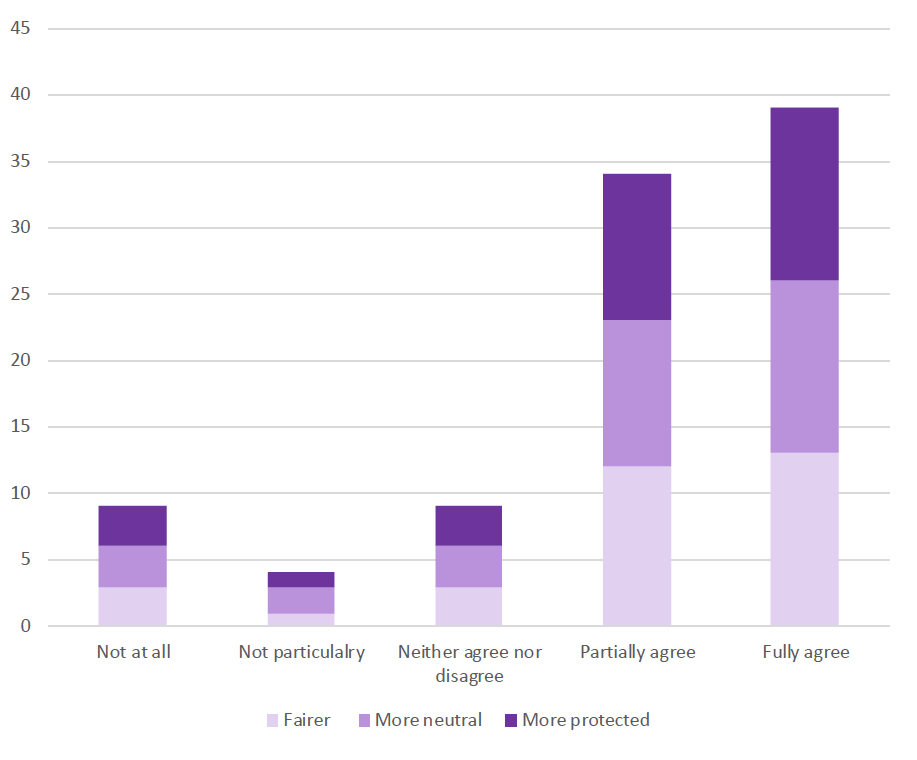
Respondents were given a list of options from which to select features they believed 'should be included within a potential future retention deposit scheme'[64]. Most selected several options demonstrating support for multiple features to be included in such a scheme (table 8 overleaf).
| n | % | |
|---|---|---|
| The scheme should be set up on a statutory footing | 23 | 70% |
| Any disputes about the operation, amount and timing of the release of retention payments will be dealt with by existing dispute resolution processes | 23 | 70% |
| The scheme can only hold retention money (plus any related interest) | 22 | 67% |
| The money will be held in trust for the payee | 21 | 64% |
| Businesses holding retentions under construction contracts (as defined by Part 2 of the Housing Grants, Construction and Regeneration Act 1996) will be required to deposit retentions into the scheme | 20 | 61% |
| Scheme operators would be required to report on an annual basis on their performance | 19 | 58% |
| Where the contract makes no such provision, the Scheme for Construction Contracts will imply relevant terms requiring retention money to be held in a deposit scheme | 12 | 36% |
| The market will deliver private provision of any retention deposit scheme | 11 | 33% |
Other general additional comments[65] were provided regarding the retentions scheme, including the below:
- The approach to quality and the need to drop the assumption that defective work is a 'given'
- Retention should be scrapped altogether
- A fast, cost effective way of chasing smaller debts to be included i.e. retention paid out on a set date if no justified objection is received
Several respondents (n5) provided the same reply. For the sake of completion this has been quoted verbatim below:
""We do not believe that an option for contracts to make provision for depositing retentions in a scheme (with the Scheme for Construction Contracts providing the fall-back provisions) is a viable one especially for small firms. There will always be the difficulty for them of trying to assess whether the contractual provisions comply with the law. The English Court of Appeal judge Lord Justice Coulson has (extra-judicially) described the Scheme's payment provisions as a "drafting nightmare". It would be far easier and tidier for them to have the matter exclusively addressed by regulation. SEC Group has already been working on the structure for a scheme based on a distributed ledger (DLT) platform. The cost involved would be 0.23% of contract value. This would be paid by the client (or just by the main contractor if it and not the client is withholding retentions from the supply chain). This percentage figure would include the cost of administration and the provision for an insurance policy to cover any shortfalls in the scheme. A detailed explanation of how the scheme would operate is attached.
The document is hosted on website: www.rdch.co.uk and the direct document link is: https://static1.squarespace.com/static/5dd3ab2c9f3951087bb5a80f/t/5df659ff4f4ce57dd2510945/1576426549775/RDCH+Flyer
It is also very important that the scheme is centralised in a single entity to allow for reduced costs, the provision of insurance, and the collection of critical data that can provide the essential transparency and trust to engage lenders and insurers, as well as providing useful data for policy makers."
Of the respondents that answered, the clear majority (70%) thought that the 'cost per contract (as a percentage) you would be willing to incur if it meant that your retention was held in trust in a retention deposit scheme'[66] should be below 1% of the contract value. Of the other respondents 12% said it should be 'between 1% and 3%', only 3% said over '3% but under 5%'.
For the 'price they would be willing to pay for a retention deposit scheme dependent on contract value'[67], more respondents agreed with this than disagreed (52% compared to 33%, respectively) (15% did not answer)
For the 'what cost would you be willing to pay (per contract) for the administration of a retention deposit scheme'[68], the clear majority of 51% said below 1% of the contract value, with 9% saying it depended on the value of the contract (39% did not answer).
Contact
Email: covid.construction@gov.scot
There is a problem
Thanks for your feedback